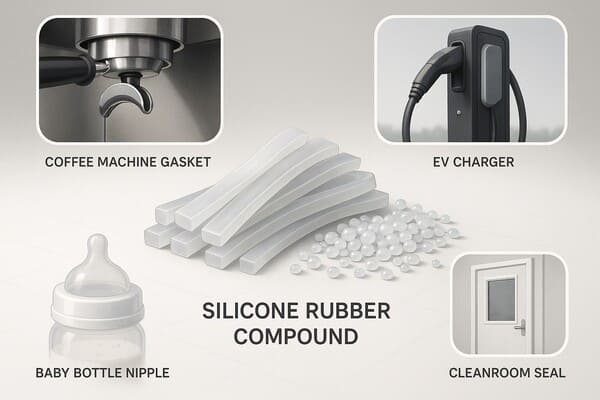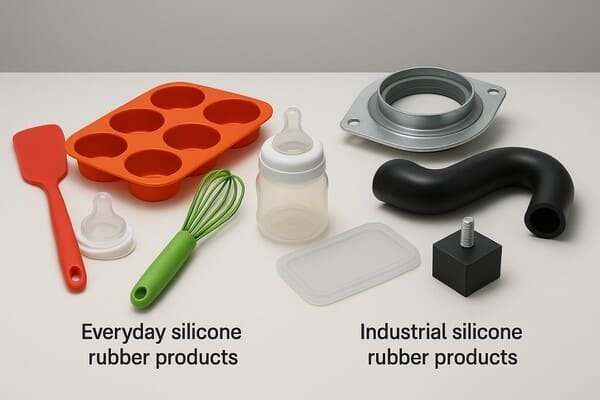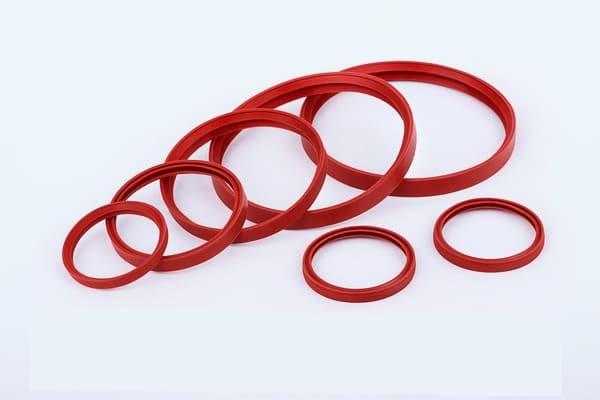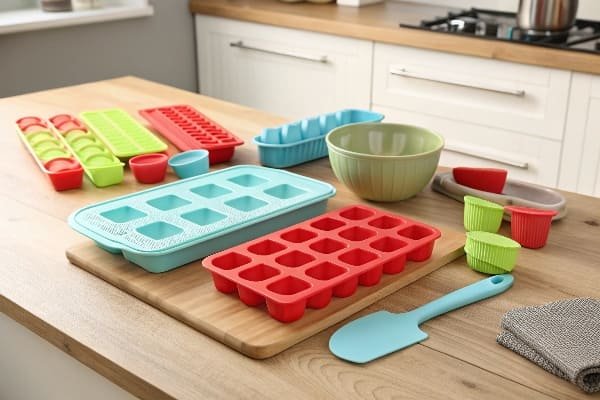I know silicone looks simple from the outside, but one compound can end up in coffee machines, EV chargers, baby products, and cleanrooms at the same time.
Silicone rubber compound is used for seals, gaskets, hoses, cable insulation, keypads, medical and food-contact parts, and many high-temperature or hygienic components that need long-term flexibility and stability.

When I work with buyers, I always start from the real job: does the part need to seal, insulate, cushion, or touch food or skin? Once we answer that, the best silicone compound and design path become clear.
What everyday and industrial products use silicone rubber compound?
Many people only think about baking molds or phone cases when they hear “silicone”, but the real usage goes much deeper into machines and factories.
Silicone rubber compound is used in everyday goods like kitchen tools and baby products, and in industrial parts like HVAC gaskets, automotive seals, and machinery vibration dampers that must survive heat, cold, and aging.

I still remember my first big order for silicone gaskets1. The end customer only saw a grey ring, but behind it were months of testing for heat, compression, and cleaning cycles2.
How silicone shows up in daily life
Kitchen, home, and consumer products
In daily life, silicone rubber compound hides in:
- Baking molds and trays
- Spatulas and oven-safe tools
- Food storage lids and seals
- Baby bottle nipples and spoons
- Wearable straps and soft buttons
These parts need soft touch, heat resistance3, and easy cleaning. Silicone keeps flexibility at low temperature and still stays stable when it meets hot oil, steam, or dishwashers. This is why people can move a baking tray from a freezer to a hot oven without seeing cracks.
Industrial and HVAC components
In industry, silicone rubber compound becomes:
- HVAC door gaskets and duct seals
- Vibration dampers and pads
- Enclosure and cabinet seals
- Expansion seals near hot air or heaters
These parts face temperature swings, UV, ozone, and sometimes chemicals from cleaning or process gases. Silicone keeps sealing force for a long time. This reduces leaks and callbacks.
Quick comparison of typical uses
| Area of use | Typical silicone parts | Main reason to use silicone |
|---|---|---|
| Kitchen and home | Bakeware, lids, spatulas, mats | Heat resistance, non-stick, easy clean |
| Baby and personal | Nipples, pacifiers, soft-touch grips4 | Softness, safety, skin comfort |
| HVAC and building | Door seals, duct gaskets, glazing gaskets | Temperature and weather resistance5 |
| Machinery and tools | Vibration pads, soft handles, keypads | Flexibility, cushioning, durability |
When I explain this to a purchasing officer, I say: if you need something soft that can live between a freezer and a hot cleaning cycle, silicone is usually on the shortlist.
Why is silicone rubber compound so popular for seals and gaskets?
Most of my own projects at Julong Rubber are not fancy shapes. They are “just” seals and gaskets6, but these parts decide if systems leak, rattle, or pass certification.
Silicone rubber compound is popular for seals and gaskets because it stays flexible over a wide temperature range, resists weather and ozone, and keeps compression set low enough for long-term sealing.

I have seen entire HVAC projects saved simply because we changed one gasket from a generic rubber to silicone and removed constant leak complaints.
What makes silicone a strong sealing material
Wide temperature window
Compared with many other rubbers, silicone keeps softness and elasticity over a very wide temperature range. Many grades can handle deep-cold conditions and still survive hot air, steam, or short-term spikes in temperature. This is critical for:
- Outdoor enclosures that see winter nights and summer sun
- HVAC systems near heaters or heat exchangers
- Appliances that run repeated heating and cooling cycles
A seal that hardens in winter or collapses in summer is not a real seal. Silicone helps avoid this.
Compression set and long-term sealing
Compression set describes how much a gasket “remembers” its shape after long compression. A low compression set means the part springs back and keeps sealing force. Many silicone compounds show good compression set7 at elevated temperature, which is one of the main reasons I choose them for:
- Oven doors and hot-air ducts
- Hot water and steam systems
- Electrical cabinet gaskets near heat sources
Weather, UV, and ozone resistance
Silicone also resists UV and ozone very well. This makes it a strong choice for:
- Outdoor junction boxes
- Solar system components
- Building façade seals
Other rubbers may crack or chalk under sunlight and ozone. Silicone ages much slower, so replacement intervals become longer.
Sealing applications in one view
| Application | Silicone’s role | Key benefits in use |
|---|---|---|
| HVAC duct and door | Frame seals and lip gaskets | Air tightness, low compression set |
| Ovens and dryers | Door gaskets and window seals | Heat resistance, repeated cycles |
| Outdoor cabinets | Perimeter gaskets and plugs | UV and ozone resistance, flexibility |
| Pumps and valves | Static seals, diaphragms, O-rings | Flexibility, chemical and heat balance |
When a buyer sends me a drawing for a seal, I always ask about temperature, compression time, and environment. If these conditions are harsh or long-term, silicone rubber compound is often my first suggestion.
How is silicone rubber compound used in food, medical, and hygiene applications?
Many people trust silicone automatically because they see it in baby products and medical devices8, but they seldom know what stands behind that trust.
Silicone rubber compound is widely used in food and medical applications for tubing, gaskets, valves, and baby products because certain grades can meet strict extraction, biocompatibility, and cleaning requirements.

In my own work, I have seen how a simple material certificate can decide if a customer wins or loses a tender in the food or pharma sector.
Where silicone appears in hygiene-critical systems
Food and beverage
In food and drink systems, silicone parts include:
- Gaskets for filling machines and bottling lines
- Seals in coffee, tea, or juice dispensers
- Tubing for low-pressure transfer of liquids
- Baking and cooking tools that touch food directly
For these uses, the silicone compound must meet food-contact regulations9. That usually means low extraction levels and restrictions on ingredients. Buyers often ask for specific test reports and a declaration of compliance.
Medical and life science
In medical and life science applications, silicone rubber compound becomes:
- Tubing for pumps and fluid transfer
- Seals and gaskets in medical devices8
- Components in respiratory and monitoring equipment
- Soft-touch patient-contact parts
Here, biocompatibility10 and sterilization methods matter. Some silicone grades can handle repeated autoclave, gamma, or chemical sterilization11. They keep softness and do not crack under stress.
Baby care and personal products
Silicone also appears in:
- Bottle nipples and pacifiers
- Breast pump components
- Wearable bands and skin-contact seals
Parents look for softness, no strong odor, and safe contact with skin and food. Buyers look for proof that the silicone compound suits these uses.
Food and medical use summary
| Segment | Typical silicone parts | Key selection points |
|---|---|---|
| Food equipment | Gaskets, valves, tubing, bakeware | Food-contact compliance, cleaning cycles |
| Medical devices | Tubes, seals, diaphragms, soft-touch parts | Biocompatibility, sterilization, clarity |
| Baby products | Nipples, pacifiers, seals, spoons | Safety, softness, taste and odor control |
When customers ask me for “food-grade” or “medical-grade” silicone, I always request more context: country of use, cleaning method, and target standards. Then I choose a compound family that already has a track record and documents in those fields.
What other special uses make silicone rubber compound stand out?
Even if a project has nothing to do with food or medicine, silicone may still be the right answer because of its electrical, fire, and special-environment behavior.
Silicone rubber compound is also used for cable insulation, keypads, fire-resistant parts, and special applications in automotive, aerospace, and electronics where high temperature, arc resistance, or soft tactile feel are important.

I once helped an electronics customer who needed a keypad that stayed soft in cold warehouses but also handled constant finger use. Silicone gave both the feel and the durability they needed.
Electrical, electronic, and fire-related uses
Cable and wire insulation
Silicone rubber compounds can be formulated for:
- High-temperature cable jackets
- Flexible insulation for appliance leads12
- Cables in ovens, motors, and lighting
They keep flexibility over temperature and can show good resistance to tracking and arcing. For moving cables, this combination is very useful.
Keypads, buttons, and control panels
Silicone’s soft feel and stable elasticity make it ideal for:
- Remote control pads
- Industrial control keypads
- Sealed button pads in outdoor or dusty areas
The compound transmits a clear “click” through domes while still sealing against dust and moisture. Pigments can match branding without losing mechanical properties, when the formulation is correct.
Fire-resistant and low-smoke parts
Some silicone compounds are designed to:
- Resist flame
- Limit smoke generation
- Keep basic mechanical form during heat exposure
These grades appear in transportation, building, and critical equipment. They are not the cheapest, but they help systems meet safety standards.
Automotive, transport, and special machinery
Silicone rubber compound also appears in:
- Turbocharger and engine bay hoses (often special blends)
- Headlamp seals and exterior lighting gaskets
- Vibration control parts near heat sources
- Special hoses in chemical and pharma machinery
In these places, silicone is chosen because other rubbers cannot handle the temperature, cleaning, or environmental conditions for long enough.
Special-use overview
| Sector | Silicone part type | Why it is chosen |
|---|---|---|
| Electrical | Cable jackets, insulation, grommets | Heat resistance, flexibility, arc behavior |
| Electronics | Keypads, buttons, soft-touch fronts | Tactile feel, sealing against dust |
| Transport | Seals near engines, lamps, HVAC units | Temperature, ozone, and UV resistance13 |
| Safety/fire | Flame-resistant seals and covers | Fire behavior and material stability |
When I discuss these projects with purchasing officers, I always connect material choice back to failure cost. If a failed seal shuts down a line or causes a safety event, silicone’s extra performance often pays for itself many times over.
At Julong Rubber, I focus on molded silicone parts and gaskets for HVAC, machinery, and custom OEM projects. I help buyers choose the right compound, design compression, and plan tests so that the final part does its job quietly for years. If you want to discuss a real drawing or project, you can reach me at info@rubberandseal.com or through www.rubberandseal.com.
Conclusion
Silicone rubber compound is used wherever parts must stay flexible, clean, and stable under heat, cold, and aging—from kitchen tools and baby products to HVAC gaskets, medical components, and high-end electrical parts.
-
Explore the versatility of silicone gaskets in various applications, from kitchenware to industrial uses. ↩
-
Understanding cleaning cycles can help you choose materials that withstand repeated cleaning. ↩
-
Understanding heat resistance can help you choose the right materials for high-temperature applications. ↩
-
Discover the advantages of soft-touch grips in enhancing user experience and comfort. ↩
-
Discover how weather resistance can prolong the lifespan of materials in outdoor applications. ↩
-
Learn about the differences between seals and gaskets and their specific applications. ↩
-
Learn about compression set and its significance in ensuring long-term sealing performance. ↩
-
Explore the materials used in medical devices and their importance for patient safety. ↩ ↩
-
Understanding food-contact regulations is crucial for ensuring safety in food-related applications. ↩
-
Explore the importance of biocompatibility in medical devices and how it affects patient safety. ↩
-
Learn about chemical sterilization methods and their role in ensuring medical device safety. ↩
-
Understanding appliance leads can help you ensure safety and efficiency in electrical devices. ↩
-
Learn how UV resistance can prevent material degradation in outdoor environments. ↩








